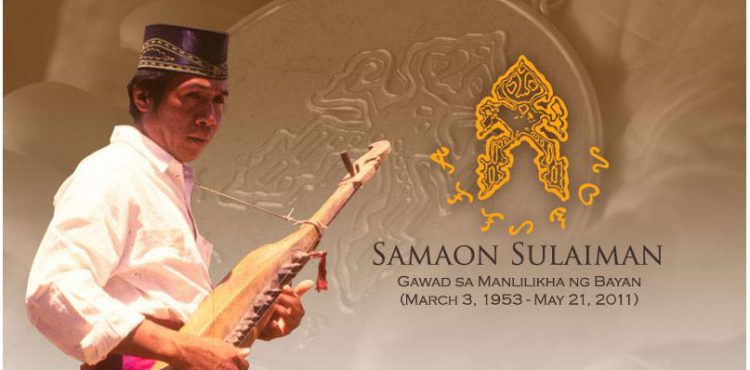
Samaon Sulaiman
Musician
(Born: 3 March 1953)
Maguindanao
The Magindanaon, who are among the largest of Filipino Islamic groups, are concentrated in the towns of Dinaig, Datu Piang, Maganoy and Buluan in Magindanao province. Highly sophisticated in weaving, okir designs, jewelry, metalwork and brassware, their art is Southeast Asian yet distinct in character.
In the field of music, the Magindanaon has few peers among Filipino cultural communities. Their masters on the kulintang (gong-chime) and kutyapi (two-stringed plucked lute) are comparable to any instrumental virtuoso in the East or West.
The kutyapi is a favorite solo instrument among both Muslim and non-Muslim Filipinos and is also played in combination with other instruments. It exists in a great variety of designs, shapes, and sizes and known by such names as kotapi (Subanon), fegereng (Tiruray), faglong (B’laan), hegelong (T’boli) and kuglong or kudlong (Manobo).
The Magindanao kutyapi is one of the most technically demanding and difficult to master among Filipino traditional instruments, which is one reason why the younger generation is not too keen to learn it. Of its two strings, one provides the rhythmic drone, while the other has movable frets that allow melodies to be played in two sets of pentatonic scales, one containing semitones, the other containing none.
Magindanao kutyapi music is rich in melodic and rhythmic invention, explores a wide range of timbres and sound phenomena – both human and natural, possesses a subtle and variable tuning system, and is deeply poetic in inspiration.
Though it is the kulintang that is most popular among the Magindanaon, it is the kutyapi that captivates with its intimate, meditative, almost mystical charm. It retains a delicate, quiet temper even at its most celebrative and ebullient mood.
Samaon Sulaiman achieved the highest level of excellence in the art of kutyapi playing. His extensive repertoire of dinaladay, linapu, minuna, binalig, and other forms and styles interpreted with refinement and sensitivity fully demonstrate and creative and expressive possibilities of his instrument.
Learning to play the kutyapi from his uncle when he was about 13 years old, he has since, at 35 become the most acclaimed kutyapi master and teacher of his instrument in Libutan and other barangays of Maganoy town, deeply influencing the other acknowledged experts in kutyapi in the area, such as Esmael Ahmad, Bitul Sulaiman, Nguda Latip, Ali Ahmad and Tukal Nanalon.
Aside from kutyapi, Samaon is also proficient in kulintang, agong (suspended bossed gong with wide rim), gandingan (bossed gong with narrow rim), palendag (lip-valley flute), and tambul.
Samaon was a popular barber in his community and serve as an Imam in the Libutan mosque.
For his exemplary artistry and dedication to his chosen instrument, for his unwavering commitment to the music of the kutyapi at a time when this instrument no longer exists in many parts of Mindanao, Samaon Sulaiman is worthy of emulation and the highest honors.
Source: Prof. Felipe M. de Leon, Jr.
